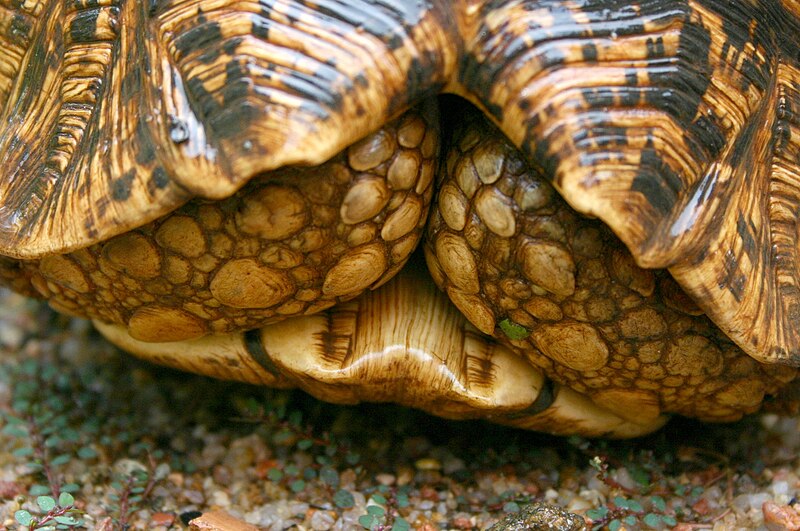Please see Part I of this article for information on this South African native’s natural history.
Leopard Tortoises as Pets
These attractive tortoises make responsive pets, but careful thought should be given to their needs before deciding to acquire one. With a possible captive lifespan in excess of 75 years and a potential weight of over 80 pounds, Leopard Tortoises are suited only for those with ample space, time and a long term commitment to their welfare. Their husbandry needs are very specific, and if not met they become ill very quickly.
Light, Heat and Humidity
Leopard Tortoises are animals of warm, sunny and usually dry habitats, and require huge, airy enclosures – glass terrariums are not recommended, even for youngsters.
High levels of UVA and UVB http://www.thatpetplace.com/pet/group/16259/product.web radiation are essential, as is a temperature gradient of 72-86 F. They do best when kept outdoors, but are intolerant of cold or damp conditions. Year-round outdoor housing is possible in some parts of the American Southwest, but humid surroundings, even if warm (i.e. in the Southeastern USA), are not suitable for them. These and other arid habitat tortoises should be maintained on well-drained substrates such as a sand/gravel mix as opposed to top soil.
Diet
 Leopard Tortoises have evolved to thrive on a diet of course, high fiber grasses…wild grasses and lawn clippings are considered to be essential foods by many successful keepers. Indeed, the finest specimens I recall subsisted almost entirely on natural forage during the warmer months (NYC area).
Leopard Tortoises have evolved to thrive on a diet of course, high fiber grasses…wild grasses and lawn clippings are considered to be essential foods by many successful keepers. Indeed, the finest specimens I recall subsisted almost entirely on natural forage during the warmer months (NYC area).
In addition to wild grasses and herbaceous vegetation, collard greens, yams, kale, dandelion, bok choy, seasonally available vegetables, dry alfalfa and Grassland Tortoise Pellets should be provided.
Leopard Tortoises grow rapidly, and their Calcium/Vitamin D3 needs appear to be quite high. I have found it useful to alternate Reptocal and Reptivite with D3 as supplements.
A diet that contains meat-based products or too much fruit will invariably lead to liver disease, stones, malformed bones and shells and other potentially fatal ailments.
Further Reading
Please see my article on Toxic Plants for tips on collecting forage (the article was written with birds in mind, but is largely applicable to tortoises).
Detailed information on the Leopard Tortoise is posted on the Turtles of the World website.
An interesting video of a Leopard Tortoise in its natural habitat is posted here http://www.youtube.com/watch?v=zI9PBQhVsQU
 That Reptile Blog – Reptile, Amphibian and Exotic Pet Care and Information
That Reptile Blog – Reptile, Amphibian and Exotic Pet Care and Information



After the Sulcata, my next choice of tortoise would be a Leopard, but for now my hands are full having 1 Sulcata, keeping up w/ the natural graze and space he needs to stay healthy is my main focus. One bit of info I did not know until today is how big Leopards can get, I’m very pleased to know that now.
Hello, Frank Indiviglio here.
Thanks for your interest in our blog and the kind words. Yes, a Sulcata is more than enough to keep most folks busy!
Please let me know if you need any further information. Good luck, enjoy and please keep me posted.
Best regards, Frank Indiviglio.